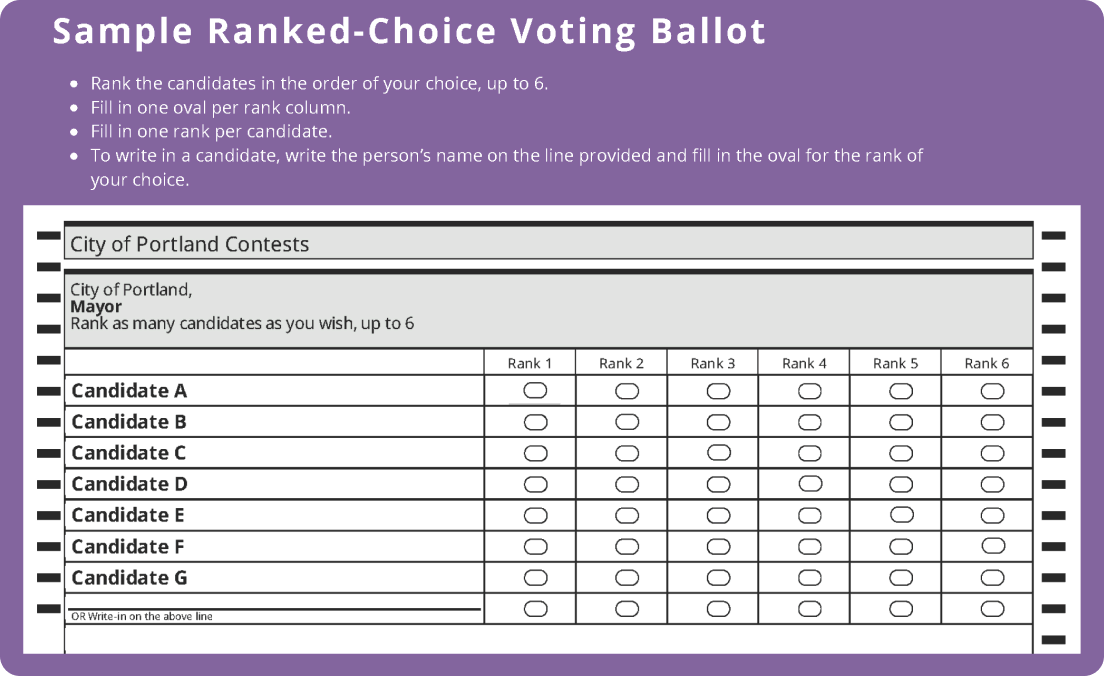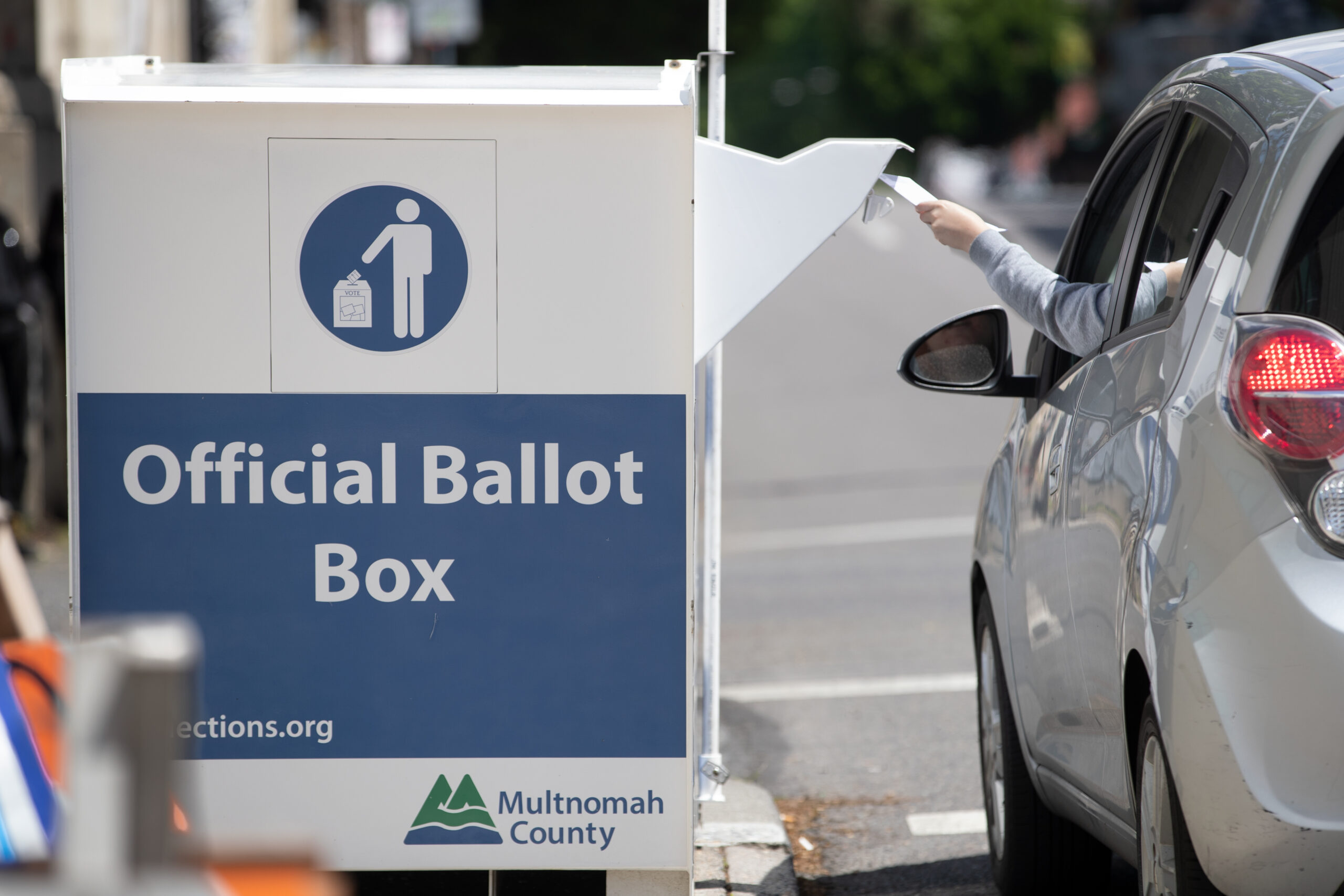Ranked Choice Voting
This November, Portland voters are using ranked choice voting to cast their ballots for Mayor, Auditor, and City Council. This allows you to rank candidates in order of preference. That means that if your top choices don’t win, your vote can still count.
Learn more below.
 Image courtesy of City of Portland
Image courtesy of City of Portland How to Fill Out Your Ballot
This election, you can rank the candidates you like in order of preference: First, second, third, and so on. You have the ability to rank as many candidates as you like (up to 6!).
Learn moreHow to Return Your Ballot
Voting from home in Oregon is as easy as 1-2-3. Here’s how to return your ballot to make your voice heard by November 5.
Learn moreHow to Make Your Voice Heard
Rank your favorite candidate first.
Pick who you like best and rank them as your #1 choice by filling in their bubble under the column “Rank 1.”
Rank up to six candidates.
For your second favorite candidate, fill in their bubble under the “Rank 2” column. Continue ranking candidates you like, up to six. Ranking all six choices on your ballot can give your vote more power in determining who represents you.
Make your vote count.
When you rank multiple candidates, that means that if your first-choice candidate doesn’t get enough votes, your vote can still help determine the winner.
Don’t like a candidate? Don’t rank them.
Ranking a candidate you don’t like means your vote could ultimately end up putting them in office – even if you rank them last. You should only rank the candidates who you feel best represent you. If you don’t like a candidate, don’t rank them.
Vote your values.
When you use ranked choice voting, you can support candidates with different backgrounds and perspectives. That means better leadership for our city, and a better path forward. Remember, you’re electing three City Council members so use your choices.
Frequently Asked Questions
- How does ranked choice voting work?
Ranked choice voting lets you rank candidates in order of preference. You put the candidate you like best as your #1 choice, your next favorite candidate as your second choice, and so on. You will be able to rank up to six candidates for Mayor and City Council on your ballot. If there’s a candidate you really don’t like, just don’t rank them.
- How many candidates can I rank on my ballot?
You will have the option to rank up to six candidates on your ballot. Even if there are more than six candidates running, you will still only be able to rank up to six.
- Do I rank everyone?
Ranking candidates is optional. If you want to only support one candidate, just rank your favorite candidate first and move on to the next contest on your ballot. Remember, for City Council, you are electing three people to represent you.
- Should I rank candidates I don’t like?
NO. You should rank the candidates you support in order of how much you want them to be elected. If you don’t want someone to win, you should not rank them.
- What happens if I make a mistake on my ballot?
If you make a mistake while filling out your ballot, don’t worry! There are a couple of different ways you can fix it before returning your ballot, which you can read more about here. You also have the option to order a replacement ballot.
Note: You cannot change your vote or request a replacement ballot once you’ve mailed or dropped off the original ballot.
- Which races are using ranked choice voting?
All City of Portland races will use ranked choice voting, including: Portland Mayor, Auditor, and 12 City Council positions. Starting in November 2026, Multnomah County will also use ranked choice voting to elect the following officials: County Chair, County Commissioners, Auditor, and Sheriff.
- How are votes counted?
In elections with only one winner, like the Mayor’s race, a candidate must secure the majority of votes (50% + 1) to win. After all first choice votes are counted, the candidate with the fewest votes is eliminated. Anyone who voted for the eliminated candidate has their votes re-allocated to their second choice. If there is still no winner, the next candidate with the fewest votes is eliminated again, and the process continues until someone secures a majority of votes.
In the City Council races where there are three winners, there is a different threshold candidates must meet to be declared a winner. Learn more about how these votes are counted here.
You can also find more answers to common questions about how RCV ballots get counted here.
- Where else is ranked choice voting used?
50 American jurisdictions and approximately 13 million voters use RCV in elections across the United States including in Maine, Alaska, Minneapolis, New York, and even right here in Benton County, Oregon.
This year, we will also be voting on Measure 117, which would allow voters to use ranked choice voting in single-winner federal and statewide races in Oregon.
How to Return Your Ballot
 Image courtesy of Multnomah County
Image courtesy of Multnomah County